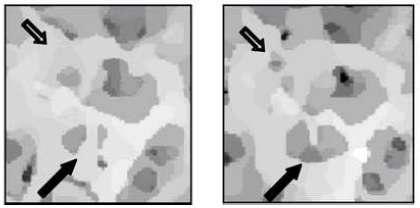
 Reproduced from J Bone Miner Res 2008;23:730-740 with permission of the
American Society for Bone and Mineral Research
Reproduced from J Bone Miner Res 2008;23:730-740 with permission of the
American Society for Bone and Mineral ResearchEstrogen actions on bone are complex. The major physiological effect of estrogen is to inhibit bone resorption. Bone cells have two kinds of intracellular steroid receptors for estrogen. When estrogen binds to the receptors, various genes become active. Estrogen also has effects that do not depend on activating the DNA.
Estrogen effects may be mediated in part by growth factors and interleukins. For example, interleukin 6 is a potent stimulator of bone resorption, and estrogen blocks the osteoblast's synthesis of interleukin 6. Estrogen may also antagonize the interleukin 6 receptors. Transgenic mice without interleukin 6 do not develop osteoporosis after oophorectomy (Poli).
This animation shows some of the changes in bone cells that happen when the estrogen levels decrease. It is based on reviews by Weitzmann MN, Syed F, and Riggs BL. Click the "next" arrow
Osteoclast apoptosis is regulated by estrogens. With estrogen deficiency, the osteoclasts live longer and are therefore able to resorb more bone. In response to the increased bone resorption, there is increased bone formation and a high-turnover state develops which leads to bone loss and perforation of the trabecular plates.
This animation shows how bone turnover would respond to lack of estrogen. For comparison to normal, see the page with other animations.
This loss of trabecular architecture occurs within 5 years of menopause, as shown in bone biopsies from women who have had a natural menopause. Recently, this has also been demonstrated in high resolution MRI images of the tibia (Wehrli FW).

 Reproduced from J Bone Miner Res 2008;23:730-740 with permission of the
American Society for Bone and Mineral Research
Reproduced from J Bone Miner Res 2008;23:730-740 with permission of the
American Society for Bone and Mineral Research
Estrogen has multiple other effects that relate to the skeleton. For example, enhanced intestinal calcium absorption can be beneficial to bones. Estrogen protects the bone from the resorptive effects of PTH. Estrogens may interact with mechanical forces to build bone. There are different effects on the endocortical surfaces and the periosteal surfaces that result in different shapes of bones in men compared to women.

